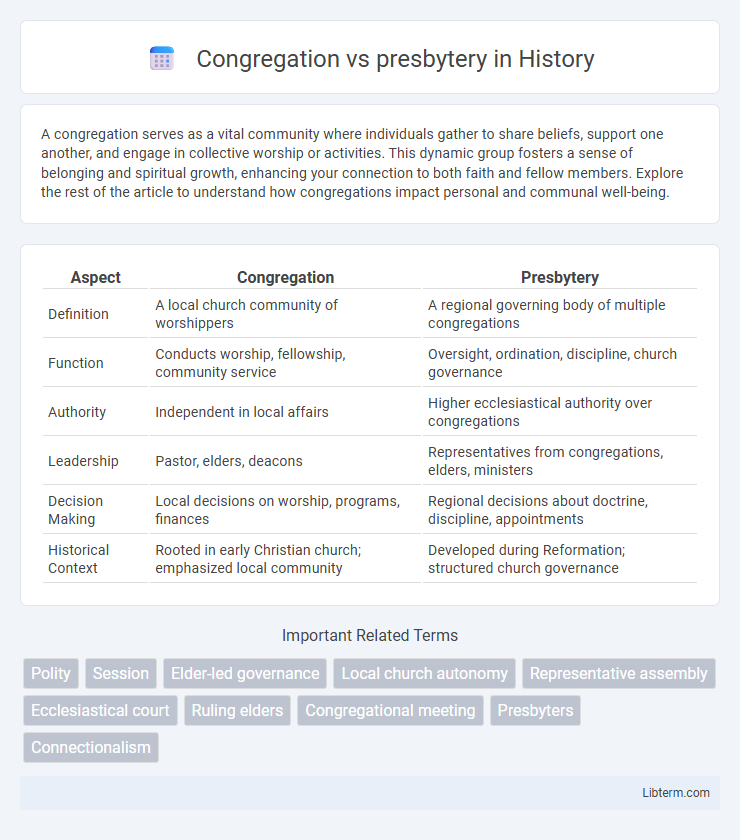A congregation serves as a vital community where individuals gather to share beliefs, support one another, and engage in collective worship or activities. This dynamic group fosters a sense of belonging and spiritual growth, enhancing your connection to both faith and fellow members. Explore the rest of the article to understand how congregations impact personal and communal well-being.
Table of Comparison
| Aspect | Congregation | Presbytery |
|---|---|---|
| Definition | A local church community of worshippers | A regional governing body of multiple congregations |
| Function | Conducts worship, fellowship, community service | Oversight, ordination, discipline, church governance |
| Authority | Independent in local affairs | Higher ecclesiastical authority over congregations |
| Leadership | Pastor, elders, deacons | Representatives from congregations, elders, ministers |
| Decision Making | Local decisions on worship, programs, finances | Regional decisions about doctrine, discipline, appointments |
| Historical Context | Rooted in early Christian church; emphasized local community | Developed during Reformation; structured church governance |
Understanding Congregation: Definition and Role
A congregation is a local community of worshippers who regularly gather at a specific place, such as a church, to engage in religious services and communal activities. It functions as the fundamental unit of Christian ecclesiastical organization, where members participate in worship, fellowship, and support one another spiritually and socially. Understanding the congregation's role emphasizes its responsibility in nurturing faith, administering sacraments, and fostering a shared religious identity.
What Is a Presbytery? An Overview
A presbytery is a governing body in Presbyterian churches that consists of elected elders representing multiple congregations within a specific geographical area. It oversees church doctrine, discipline, and administrative matters, ensuring consistency and accountability among affiliated congregations. This collective leadership contrasts with congregational governance, where each congregation operates independently with authority vested solely in its members.
Key Structural Differences Between Congregation and Presbytery
A congregation is a local body of church members who gather regularly for worship, fellowship, and spiritual growth, typically led by a pastor or minister. A presbytery is a regional governing body composed of multiple congregations, represented by their elected elders and ministers, responsible for oversight, ordination, and doctrinal discipline. Key structural differences include the congregation's focus on local ministry and worship, while the presbytery handles broader administrative authority and connectional oversight across churches within its jurisdiction.
Historical Development of Congregation and Presbytery
The historical development of congregation and presbytery reflects distinct organizational structures within Reformed Christianity, evolving from early church practices and the Scottish Reformation. Congregations traditionally functioned as local assemblies of believers governing their own worship and discipline, emphasizing the priesthood of all believers. Presbyteries emerged as regional governing bodies composed of multiple elders from various congregations, established to maintain doctrinal unity and oversee church order across wider geographic areas.
Governance: Decision-Making Authority in Congregation vs Presbytery
Congregation governance centers on local decision-making authority, where members actively participate in choosing church leaders and shaping community priorities. In contrast, presbytery governance involves a regional body of ordained ministers and elders who collectively oversee multiple congregations, ensuring doctrinal consistency and resource distribution. This hierarchical structure delegates significant authority to the presbytery, balancing individual congregation autonomy with broader church accountability.
Responsibilities and Functions: Congregation vs Presbytery
The congregation primarily handles worship services, local ministry activities, and pastoral care within its church community, focusing on spiritual growth and member engagement. The presbytery oversees multiple congregations, providing governance, ordination of ministers, doctrinal oversight, and resource allocation to maintain denominational standards. Together, the congregation and presbytery ensure local ministry effectiveness while upholding broader ecclesiastical order and accountability.
Leadership Structures: Elders, Ministers, and Committees
Congregations typically operate under a leadership structure composed of elders who oversee spiritual guidance and ministers who conduct worship and pastoral care, often supported by various committees handling administrative and community functions. Presbyteries function as regional governing bodies in Presbyterian denominations, consisting of elected elders and ministers from multiple congregations, tasked with broader oversight, ordination, and doctrinal discipline. Both leadership models emphasize shared governance but differ in scope, with congregations focusing on local church management and presbyteries on interchurch coordination and accountability.
Interaction and Accountability Between Congregation and Presbytery
Interaction between congregation and presbytery is characterized by regular communication and mutual guidance, ensuring that congregational decisions align with broader denominational standards. Accountability is maintained through presbytery oversight during pastoral appointments, doctrinal adherence, and financial transparency, fostering a balance of autonomy and supervision. This reciprocal relationship supports spiritual growth and governance integrity within the Presbyterian tradition.
Worship Practices and Community Life
Congregation worship practices emphasize direct participation, including spontaneous prayer, singing, and Scripture reading, reflecting a more localized and community-centered approach. In contrast, presbytery worship practices often follow a structured liturgy with ordained ministers leading, highlighting order and doctrinal uniformity across multiple congregations. Community life within a congregation fosters intimate relationships and mutual support among members, while presbytery organizes larger networks of churches, promoting accountability and collective decision-making in governance.
Contemporary Challenges and the Future of Congregation and Presbytery
Contemporary challenges for congregations include maintaining engagement amid declining membership and adapting to digital worship trends, while presbyteries face complexities in governance and resource allocation across diverse churches. The future of congregations depends on embracing technology and fostering community relevance, whereas presbyteries must innovate collaborative leadership models to support congregational resilience and growth. Both entities are increasingly focusing on inclusivity, social justice, and sustainable ministry practices to navigate shifting cultural landscapes and ensure long-term viability.
Congregation Infographic

 libterm.com
libterm.com